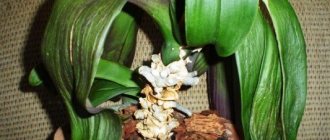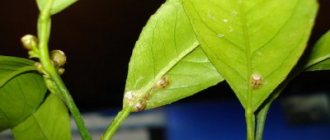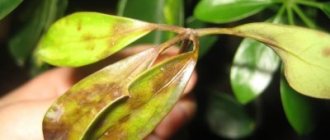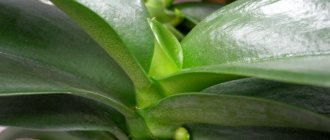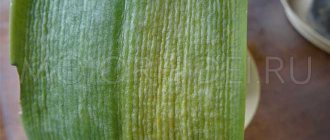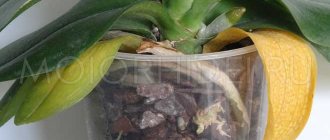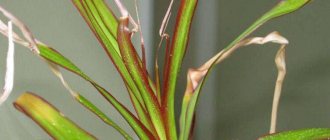What to do if an orchid has leaves on its peduncle? Birth of a baby
After the end of flowering, a lonely flower-bearing arrow remains in the flowerpot. If it remains alive and green, without signs of drying out, then after a while dormant buds may wake up , from which the following can form:
- lateral peduncle , thanks to which the orchid will bloom again;
- small leaves that will eventually develop roots. the children (shoots) that develop - small, cavity-formed orchids.
Often they appear not only on the flower stalk, but also grow from the roots (basal children) or from buds in the leaf axils.
On the peduncle
The formation of children on the flower stalk means that even an inexperienced amateur can grow one or several independent plants without extra effort, without injuring the orchid.
This method is most convenient for vegetative propagation of orchids at home.
Baby on a peduncle.
Conditions for appearance
The most suitable period for the formation of children comes after the end of a long flowering period. The plant must have a well-developed root system and at least two pairs of large leaves.
As a rule, there are 3-4, sometimes more, dormant buds on the peduncle. In order for them to wake up, it is necessary to cut off the peduncle above one of them at a height of 2-3 cm.
Trimming the peduncles does not guarantee that the buds will wake up; after pruning, the peduncle can remain dormant for a whole year and then dry up. More often, pruning stimulates the awakening of the remaining dormant buds that are located on the flower-bearing arrow.
Sometimes children form on their own, but in some cases, even if the plant is in optimal conditions, stimulation of their forcing is necessary . This is facilitated by:
- daily temperature fluctuations. At night it should be cool - up to +17-18℃, during the day - up to +27-30℃. These conditions are most favorable in the spring and summer on a glazed balcony;
- poor watering should be combined with high relative humidity. When kept indoors, this requires regular spraying and placing the plant on a tray with damp moss or pebbles;
- a large amount of intense diffuse light.
The probability of the formation of children on flower-bearing arrows greatly increases with the use of special preparations - growth stimulants, primarily cytokinin paste.
When can you separate?
At the first stage, it is quite difficult to distinguish the baby from the side arrow on the peduncle, but as it grows, the differences will become more and more noticeable:
- The baby's leaves appear first, then the roots develop;
- 6 months after the baby appears, she already has 2 pairs of leaves.
After six months, the formed process is ready for separation. By this time, the baby should have formed 3-4 roots about 5 cm long. If the baby’s roots are too small, then the transplanted orchid will take a long time to take root and hurt. In this case, you should postpone the separation and wait for the roots to grow.
The baby can be separated when it has formed roots.
Separation technology. How to eliminate the main risks for the plant?
In order to eliminate possible risks for an adult plant, first of all, prepare the tools and related materials for work:
- disinfect garden pruners, knife or scissors;
- crush several tablets of activated carbon;
- prepare a transparent glass or flowerpot with drainage holes;
- purchase or prepare your own substrate for planting a small orchid.
The volume of the glass must correspond to the volume of the root system : the roots in it must be placed quite tightly.
Separating the baby from the flower-bearing arrow is quite simple:
- when separating at the edges, the children leave up to 2 cm of the stem of the flower-bearing arrow;
- the cut is sprinkled with crushed activated carbon and allowed to dry for half an hour;
- the baby is transplanted into a separate pot with a special soil mixture and placed in a greenhouse.
After nine months, the small orchid no longer needs greenhouse conditions, and the first flowering can be expected in 2-3 years.
In the leaf axil
From the buds, which are located in the axils of the leaves, peduncles develop in some climatic conditions, and lateral shoots (babies) in others . Sometimes the plant produces several shoots at once.
A baby growing from the axil of a leaf.
During the period of formation of shoots, the orchid requires ordinary care and regular watering. At this time, fertilizing is carried out with fertilizers containing a high nitrogen content, which stimulates the growth of the baby.
How long can a mother plant grow?
In order for the baby to be fully formed, it must spend about six months . Its maturity is determined by the number and length of roots.
Reasons for the appearance of babies on the stem
Experienced flower growers believe that the formation of babies on the trunk or in the leaf axil is associated with unfavorable growing conditions:
- stem injury;
- dying off of the growth point;
- long-term drought;
- with the development of a flower-bearing arrow from the center of the rosette.
Dying of the growing point
Typically, stem babies appear when the growing point dies or after a peduncle has developed from it. Such a plant will no longer grow or bloom . The baby that has formed at the growth point will give rise to a new plant.
Key Features
If the babies appear on the stem itself, it is not recommended to separate them , since they do not form their own roots and if separated incorrectly, the mother plant may die.
Leaves have appeared on the orchid's shoot, what to do?
Phalaenopsis are often called "butterfly orchids" because their charming flowers come in a variety of shapes, sizes, patterns and colors - white, yellow, pink, red, purple, brown and green - reminiscent of tropical moths. The elegant lip of the flower, often contrasting in color, stands out effectively against the background of patterned (striped, netted, tiger, speckled) or evenly colored flower petals, reaching 8 cm in diameter. There are two types of phalaenopsis: standard and miniature. During flowering, standard phalaenopsis species reach a height of 1 meter with a dozen or more flowers on a long peduncle; miniature, no more than 30 cm high, with fewer smaller flowers on a short peduncle. Different types and varieties of phalaenopsis bloom at different times, each orchid can bloom up to 3 times a year. The tongue-shaped, wide leaves of phalaenopsis (usually 4-5 of them) appear in pairs on the rhizome growing upward. The flower arrow appears at the base of the last formed leaf. The falling of the lower old leaves is normal, so the orchid does not grow too much. There are no pseudobulbs in phalaenopsis, but there are a huge number of roots with which in nature these orchids firmly hold onto the bark of trees or rocks (among phalaenopsis there are both epiphytes and lithophytes). Phalaenopsis are unpretentious evergreen, ever-growing orchids; Their species and hybrids that bloom almost all year round are ideal for beginners. With proper care, phalaenopsis bloom profusely, for a long time and live in the house for up to 7 years. Phalaenopsis requires a warm place with diffused light without direct sunlight. Phalaenopsis also grow well in the back of the room with sufficient artificial lighting. With a lack of light and when the temperature drops below 16 degrees, the buds of phalaenopsis prepared for flowering may fall off. The temperature of keeping these heat-loving orchids should not be lower than 18 degrees (except in autumn, when it is necessary to keep phalaenopsis for about 1-2 months at a temperature of 16 degrees for the formation of flower buds); The comfort zone for phalaenopsis is within 22-24 degrees. Watering should be very moderate all year round, especially in winter. The substrate should not dry out too much, but before the next watering, let it dry slightly - the roots of phalaenopsis, in addition to water, need air. Excessive watering may cause fungal infections. Irrigation water should not get into the growth point - the center of the rhizome in order to avoid its rotting. You can water phalaenopsis using the “bathing” method, half-immersing the pot with the orchid for a short time in a bucket of soft water so that the substrate is saturated with moisture. Phalaenopsis requires constant maintenance of high air humidity in all possible ways. Spraying the leaves and air around the orchid should be carried out in the finest spray mode, so that the water comes out in the form of “fog” and falls on the leaves in the form of “water dust”, and not droplets, which, when flowing, can fall into the core of the rosette of leaves, which will lead to to rotting. When spraying, water should not get on the flowers. In dry air, the orchid can be affected by scale insects. Phalaenopsis is transplanted once every 2 years into a rough, loose orchid substrate; The pot is taken a little larger than before. When replanting, you need to minimize damage to the fragile roots in contact with the edges of the pot; The pot is taken a little larger than before. In the summer, 2 times a month, orchids need to be fertilized in a low concentration (sick plants cannot be fertilized); during the rest of the year, including winter, they are rarely fertilized in an even lower concentration. Phalaenopsis do not form pseudobulbs and reproduce by “babies” appearing on flower stems; When the roots of young shoots reach a length of 5 cm, they can be planted in a separate pot. Phalaenopsis flower shoots are beautifully curved or drooping (and on one flower shoot an orchid can bloom 2-3 times if you cut the flower stem above the 3rd or 4th node until it has completely bloomed). Shortening the stem helps
The most frequently asked questions about orchid culture
The most frequently asked questions about orchid culture
What are the simplest orchids? Is it possible to grow your own orchids from seeds? Leaves have appeared on the peduncle of the phalaenopsis, what are they? What to do with faded flower stalks on phalaenopsis? Is it true that orchids are poisonous plants? Do all orchids smell? How to fertilize orchids? What does the fertilizer formula mean? How often to water orchids? How can I remove the white coating of calcium salts on the leaves? My orchids are not blooming, why? Why do orchids drop their buds? Why do orchid roots come out of the pot, and is it dangerous? How much light do my orchids need? Is it possible to grow orchids under artificial light? The simplest orchids are phalaenopsis and cattleya. Phalaenopsis grows well in north-facing windows, in low light, in constantly warm and humid conditions. Cattleyas easily tolerate direct sunlight, and can be kept even on southern windows, with only a little shading from the midday sun. Cattleyas easily tolerate a slight drying of the substrate between waterings. Phalaenopsis and cattleya do not require any additional conditions for cultivation (greenhouses, additional lighting, cold storage, etc.)
Is it possible to grow your own orchids from seeds?
Orchid seeds are very small, dust-like, and although in nature orchids, of course, reproduce by seeds, this process is very long (several years). In addition, in nature, out of millions of seeds, only a few survive. Artificial seed propagation of orchids requires special equipment and knowledge.
Leaves have appeared on the peduncle of the phalaenopsis, what are they?
Some species and varieties of phalaenopsis easily produce babies on peduncles. The leaves develop first, and then the roots appear. With the appearance of 2-3 developed roots, the young plant can be separated from the peduncle and planted. As a rule, such plants bloom within a year after planting.
What to do with faded flower stalks on phalaenopsis?
You should not cut off green flower stalks, firstly, an infection may get into the wound, and in addition, old flower stalks may continue to bloom after some time.
Is it true that orchids are poisonous plants?
No. There are no poisonous plants among orchids. Some types of orchids can cause an allergic reaction, but nothing more. Many orchids are used for food: the well-known vanilla; many orchids are used in Asian cuisine and folk medicine.
What does it look like?
The arrow looks like a long stem (in favorable conditions it can reach a length of 80 - 100 cm) of green color, cone-shaped, without flowers, which most often grows above the place of previous flowering. The arrow is not smooth, but has irregularities - places where plant buds form: dormant and flowering. From the flowers, buds and orchid flowers are formed, and from the dormant ones, a side arrow or a baby may appear.
Next you can see the photos showing the arrow of the orchid:
How is it different from other parts of the plant?
Often, novice flower growers cannot determine what the orchid has produced: a root or an arrow . Indeed, only a florist with many years of experience can accurately identify the part of a plant, especially at first. But after some time, when the process reaches 1 cm in length, this will not be difficult to do.
Immediately after its appearance, the root begins to look down (stretches towards the soil and nutrients in it), and the arrow begins to look up (stretches towards the light), just like the root baby. The root is smooth, and the arrow contains "scales". The root most often grows from the neck of the plant trunk, the shoot - between the leaf plates.
We invite you to watch a video on how to distinguish the peduncle from other parts of the orchid:
Preparation
Any method of propagating phalaenopsis requires care and a clear sequence of actions by the home grower:
- carry out work with gloves:
- the knife must be well sharpened;
- pre-disinfect the tools - boil or wipe the blade with an antiseptic;
- Have charcoal on hand to sprinkle on the “wounds” to protect against bacteria and dry the cut.
Role” in the life of a plant
The arrow of an orchid performs a reproductive function. It most often produces babies - small copies of the orchid itself. After they produce a couple of leaves and 3-4 roots, they can be rooted.
In addition, the peduncle is involved in the appearance and development of flowers and buds , nourishes them with water and nutrients, thereby continuing to perform a reproductive function. Each orchid flower contains a seed capsule in which the seeds ripen after pollination by insects. An orchid can also be grown from seeds, but this can happen either in a natural environment - the tropics, or in laboratories, since this process is long and intricate.
How did the flower shoot?
After the period of active growth of roots and leaves, the orchid enters a resting phase, during which the plant shoots out an arrow. Most often this period occurs in autumn, but in good conditions the orchid can bloom several times a year.
An orchid shoot is released from the axil of a leaf , usually the lowest one. The leaf axil is the place where the orchid leaf comes into contact with its trunk. The arrow breaks through the sheet and tends upward. The appearance of the arrow occurs under the influence of many factors: lighting, temperature, watering. If favorable conditions are not created for the orchid, then the formation and release of a peduncle will be impossible.
Substrate of poor quality
For cultivation, a substrate is used, consisting mainly of pieces of pine bark. Other ingredients are peat chips, sand, pieces of charcoal, chopped dry sphagnum moss, fine expanded clay, even polystyrene foam.
Ordinary soil for indoor plants is not suitable for orchids due to its high moisture capacity and “oversaturation” with minerals. In such conditions, root rot develops quickly and the plant will not bloom.
To form a peduncle, it must be transplanted into a substrate of suitable quality. During the transplantation process, be sure to inspect the roots and cut out all dead tissue affected by rot.
What to do during this process?
- Place the container with the flower in a well-lit place. Windows facing south, southeast and southwest are suitable for this.
- If daylight hours last less than 12 hours, then the orchid must be placed under an additional light source (fluorescent lamp, phytolamp).
- Provide systematic moderate watering with settled or boiled water at room temperature.
- Continue to feed the plant if this was done before the arrow was released.
We invite you to watch a video containing recommendations for caring for orchids that have released a peduncle:
What to do if you can't escape?
- Arrange a temperature difference . The difference between the thermometer readings at night and during the day should be 5C – 7C. A similar difference can be achieved by placing the orchid pot on a heated balcony or terrace.
- Provide enough light for the plant. The required daylight hours are 10–12 hours. In the cold season (autumn, winter), the flower must be illuminated with a phytolamp.
- Ensure proper watering . The orchid requires moderate, systematic watering before flowering and when the arrow appears. But it is important to remember the main principle: do not flood the roots! It is necessary to constantly monitor the condition of the root system and substrate.
Monitor the humidity level in the room where the orchid is located. To release the arrow, the optimal humidity should be 30% - 40%.- Provide the plant with fertilizers based on potassium and phosphorus: they have a beneficial effect on the formation of flower buds.
- Scare . If the above points have been completed, but the orchid has not released an arrow, then it is recommended to arrange a stressful situation for it: reduce watering to a minimum and move the pot to a cooler place.
Some florists use special chemicals to stimulate orchids to bloom. "Epin" is very popular. They should spray the plant daily in the morning.
You can also water the plant by adding 3 to 5 drops of the drug to the water (details in the instructions).
We suggest watching a video about why an orchid does not produce a peduncle and what to do in this case:
Low humidity and temperature
The orchid is originally a tropical plant. Its homeland is characterized by high air humidity (70-80%) and temperatures of 25-30°C in summer and 20-23°C in winter. A necessary condition for flowering is a difference between day and night temperatures of 5-7°C.
Since it cannot be sprayed, air humidity is increased using:
- special humidifier devices;
- “company” of other plants;
- containers with cool water placed around the room;
- strips of damp sphagnum moss wrapped around a pot or placed in a tray, coconut fiber.
In winter, the pots are moved away from radiators and other heating devices that dry out the air greatly.
The new arrow broke
- Do not leave a broken arrow on the plant, do not glue it with tape, adhesive tape, or bandage it.
- Cut with sharp and sterile scissors 1–2 cm above the dormant bud. There is a high probability that a lateral peduncle will form from the dormant bud.
- If the peduncle breaks at the root, then you need to cut it off completely, trying to leave a small stump 1-2 cm high.
- Sprinkle the cut area with cinnamon or crushed activated carbon.
- A broken arrow can be placed in water, changing it periodically. An orchid can begin to bloom this way.
To prevent such cases from reoccurring, it is necessary to provide the plant with a habitat in which the likelihood of causing mechanical damage to the flower will be reduced to zero. Since plastic pots are quite unstable, it is advisable to place them in pots that are more stable: glass or ceramic.
Methods of resuscitation for diseases
If, as a result of improper location and lighting, the health of the orchid is at risk, the leaves have turned yellow, the roots have atrophied, then, first of all, they arrange a quarantine in the shade, the atrophied roots are cut off, the sections are rubbed with charcoal and watering is organized by immersion. After these procedures, the location of the flower is changed.
- If not properly cared for, fungal diseases occur and lumps form on yellowed leaves. Treatment is carried out with solutions of fungicides and sometimes by removing diseased parts of the flower.
- Bacterial stains. Usually, old leaves are affected, which must be removed and the sections treated with charcoal and bactericidal preparations.
- Root atrophy. The roots have dried out and are no longer able to perform their functions. Phalaenopsis resuscitation, for example, is carried out by division and transplantation. Urgently change care, temperature regime and location. It is also characterized by dried leaves.
- Putrefactive disease (root rots). Improper humidity, watering and temperature conditions can lead to this disease. The flower may look healthy for a long time, although putrefactive lesions are already developing. Resuscitation will help to save the orchid, which is carried out by cutting off the rotten parts and urgent transplantation with mandatory quarantine for a week.
Possible problems
It often happens that the arrow is released, but does not develop further, but seems to freeze in place. Or another option is possible: the peduncle has grown, but has begun to dry out. The reasons for such phenomena are directly related to the fulfillment of the basic requirements for the maintenance of an orchid.
- improper lighting;
- excess or lack of fertilizers;
- problems with the root system;
- over- or under-watering;
- infectious diseases and pests;
- incorrect temperature.
How to care?
In order for an orchid to send out its arrow and enjoy its flowering for a long time, you need to provide it with comfortable living conditions. To do this you should:
- Maintain the room temperature in summer: +22-25ºС, in winter +16-18ºС.
- Place the pot in the sun, but not under scorching rays. In summer, it is recommended to shade the window.
- Maintain humidity during the growing season within 50-60% with a household humidifier, and for releasing a peduncle - 30% - 40%.
- Ventilate the room regularly.
- Water once a week; in between, the soil should dry out completely. To release the peduncle, the “dry” period can be extended.
- Use warm and purified water.
- Fertilize orchids with fertilizers containing potassium and phosphorus.
The moment the orchid's arrow appears, real joy comes to the gardener. But it is important to remember that the key to the future successful flowering of a plant is compliance with the basic requirements for the conditions of keeping the epiphyte, especially at the moment when the plant is most vulnerable.
If you find an error, please select a piece of text and press Ctrl+Enter.
>
Inappropriate fertilizers or lack of fertilizing
Universal fertilizers for indoor plants, and even more so folk remedies for orchids, are strictly contraindicated. They need specialized feeding.
Phosphorus is required for the formation of flower stalks, so its presence in the composition is mandatory. With an excess of nitrogen, it “fattens”, increasing green mass, but does not bloom. She needs fertilizers with a minimum concentration of this macronutrient.
Fertilizing is combined with watering, dissolving the fertilizer in water. They are carried out no more than once every two weeks.
